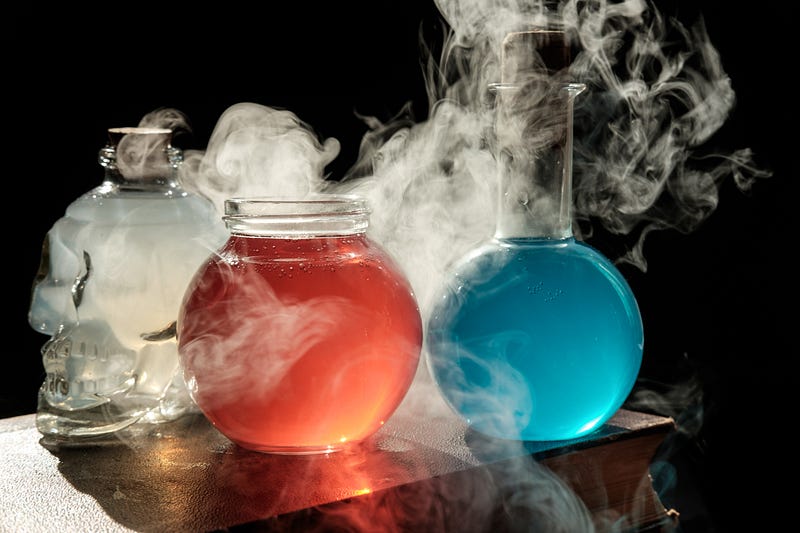The Transmutation of Alchemy
Roxanne Lee, Environmental Science and Policy, 2019

Human beings are not rational creatures. We are prone to superstition, bias, habits, and other subjective behaviors. Even the things we create that are supposed to be objective, like science, hold traces of this selfsame bias and superstition. Chemistry, the science of the composition of materials and transformations they can undergo, is a very old field with roots in many different crafts and cultures. One of chemistry’s least-scientific roots is in the field of alchemy.
Its practitioners, alchemists, were mainly concerned with the change or transmutation of matter and achieving perfection through that change. Alchemy has been practiced across the world, with the practice appearing in ancient Egypt, Greece, Persia, India, China, and Europe. It was first practiced in ancient Egypt by the alchemist Zosimos of Pnaopolis, who lived in the end of the Hellenistic period (c. 300 BC to 300 AD). It then spread from Egypt through parts of the Greek world. The Islamic world was incredibly important in the spread of alchemy, as many alchemic texts were translated from Greek to Arabic. Islamic scholars were also essential in modifying Greek alchemy, adding ideas from other parts of the world, and for beginning to use the scientific method to document their alchemic exploits. Alchemy is thought to have traveled from the Islamic world to medieval Europe during the Crusades, where it was translated from Arabic to Latin, and it enjoyed a resurgence of popularity during the Renaissance.
Just as alchemy had different names in different countries, alchemy also had different ideal end goals depending on the region in which it was practiced. One of the greatest aspirations in Chinese alchemy was the production of an elixir of life, a substance that could grant people immortality. In Medieval European alchemy, on the other hand, one of the guiding goalposts was the creation of the Philosopher’s Stone, a material that would be able to change lead into gold.
In the pursuit of impossible goals, alchemists across the world created tangible, valuable results.
In the pursuit of impossible goals, alchemists across the world created tangible, valuable results. In the 9th Century AD, Chinese alchemists invented gunpowder. Indian alchemists made impressive contributions to metallurgy, creating high carbon steel that was exported throughout Asia and Europe. Abū Mūsā Jābir ibn Hayyān (721–815) is credited with using over twenty types of what is now basic chemistry equipment in his alchemic experiments, and he was the first to describing many chemical processes. Hennig Brand, a German 17th century alchemist, inadvertently distilled phosphorus when looking for a way to create gold.
Alchemy’s path from a magical, spiritual art to modern sciences like is not an exact one. Different regions modified their own alchemic practices or began to pursue practices we would liken to modern science at different points in time for different reasons. Generally, practitioners started to turn their focus toward more attainable aspects of the art, like medicine or manipulating metals, when the more spiritual aspects of the art consistently eluded them.
Hennig Brand, a German 17th century alchemist, inadvertently distilled phosphorus when looking for a way to create gold.
Even as alchemy began to transform into what we would today recognize as chemistry, it did not dissipate entirely. What is widely considered the first chemistry textbook, Alchymia, was published in 1597 by German chemist Andreas Libavius, who wanted chemistry to be practiced with no magic involved by anyone to be able to study. Despite this, Libavius still believed in many alchemic concepts. Many notable scientists were either alchemists themselves, like Isaac Newton, or were influenced by alchemists, like Robert Boyle, a 17th century scientist who made contributions to the development of chemistry and took substantive influence from the works of German physician and alchemist, Daniel Sennert. Even with the spread of chemistry, alchemy was still practiced, albeit less, in Europe through the 19th and 20th centuries.
Modern chemistry and science did not arise in spite of alchemy, but rather because of it. Alchemy, no matter how much magic and mysticism involved, was still significant precursor to chemistry and other fields, as it encouraged practitioners to explore the world around them while taking notes. Its influence served as the supporting roots for later fields, and its spirit will persist for years to come.